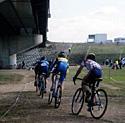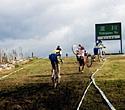
Recently on Cyclingnews.com |
Tales from the muddy, Japanese peloton, January 29, 2004
Japan gets 'cross
If you think cyclocross is restricted to a few rainy Northern European nations and a good handful of US fanatics, think again. Japan has a burgeoning 'cross scene, though the venues and courses are often unusual, as David Alvarez reports.

|
The pack strings out along a man-made riverbank with concrete embankments, passing under a highway overpass. A marching band practices its routine along the race course. In the background, the world's leading dioxin-producing smokestack puffs away. This can only be cyclocross in Japan.
Most people are surprised when I mention the popularity of cyclocross in Japan. But despite insistence among some members of the cycling community that 'cross is or should be restricted to Belgium, the sport fares pretty well here. Up and down the mountainous, island nation are local cyclocross series that feature stiff competition, decent fan support (albeit mostly family and girlfriends), and a wide number of ideas of what a cross race course should be.
Japan is known in the cycling world almost exclusively for a handful of manufacturers, predominantly Shimano. Sadly, the racing scene doesn't compare to the size of the industry, as evidenced by the lack of high-caliber athletes riding abroad. Still, road and mountain bike racing attract a respectable number of competitors and have their own national race series.
One area where both road and mountain biking struggle is access, mostly due to lack of support from authorities. Road access is hard to obtain, so many road races are held on closed park circuits, which were not necessarily built for road racing. A standard elite race is usually no longer than 80 kilometers. Entry fees, on the other hand, are often as high as 50 or 60 US dollars. The true cynic will factor this out to about 50 cents a minute to race. Plus, the level of over-organization means you have to deal with getting flagged off the course if you flat and thus miss that lap's time cut.

|
Thus cyclocross, with its laid-back atmosphere, familiar faces, low entry fees, and reasonable driving distances, is an easy and fun alternative to the nightmare that can be domestic road racing.
Course design in Japan has its own flavor, to be sure. There are two main styles of courses - that running up and down a man-made river bank, and that running up and down steep hills in a rural park. One memorable course, out next to the Hiroshima airport, was more than half on-road, and featured a death-defying steep descent followed by a staircase so long it brought tears to my eyes. Bike pits are sometimes on the very fastest parts of the course, making dismount and bike swap a hazard. This is all in the name of fun, of course.
And yet the sport grows. Japan's only UCI cyclocross race took place in late November in Shiga prefecture, about an hour from Osaka. A strong field of 49 elite riders lined up under cloudy skies and partially drizzly skies. The course, almost completely flat, snaked up and down a swollen riverbed, a combination of mud and sand. In the end, it was Keichi Tsujiura, Japanese national champion, powering along and handily winning the race (and lapping a good portion of the field at the same time). Local 'cross stalwart, Masahiko Mifune, who spent nine years racing in Belgium, had a strong ride to finish on the podium as usual.

|
The Shiga race was part of the Kansai series, arguably the toughest in Japan. It's an eight-race series in and around the Kyoto, Kobe, and Osaka area. This year Mifune has been tearing up the courses, stopped only by the occasional mechanical. Last year's series champion, 2003 Asian MTB champ Noguchi, has missed a number of races, and the fight is for second place now going into the final race in Kyoto. Being about 15 kilograms heavier than the average rider (and I'm on the lighter side among racers back home), the flat courses suit me best. Still, it's an hour of agonizing pain, snot dripping from nose, eyes watering and turning those little gears as fast as you can.
Admittedly, there is a pretty steep drop-off from the top riders down to the bottom of the pack. Still, you have to give the Japanese riders credit - despite being in a minor segment of a sport that is not supported at all, there are a good number of talented, enthusiastic athletes. Over the last decade, more and more Japanese riders have been participating in cross races in Europe, and for the first time this year, Japan fielded some Division III professional teams. With continued growth in the sport, Japan should continue to have more presence in international racing. And to be assured, cyclocross will continue to thrive.
Photography
Images by David Alvarez
- Running up that hill - okay, it's the Yodogawa riverbank, a typical upslope obstacle.
- Under the bridge - the fields under Highway 2.
- Stepping out - long flights of steps are a painful feature of Japanese 'cross.
- Jump! A CTS rider runs the barriers at Shiga.
- Stepping up - more steps, this time at Yodogawa.
- Take me to the river - off the back on the riverbank in Fukuchiyama.
